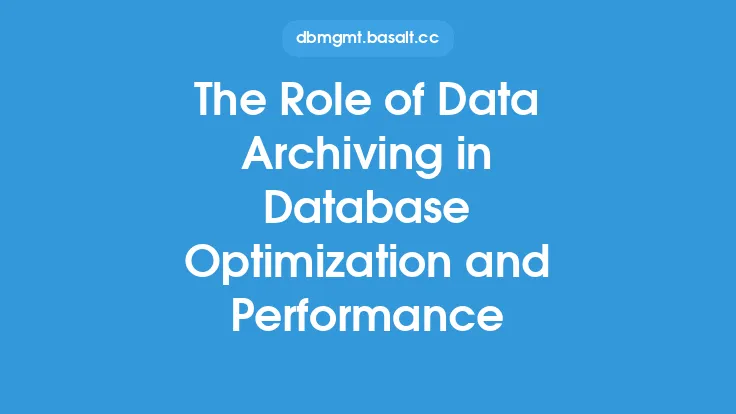Database performance and scalability are crucial aspects of any database management system. As the volume of data grows, the need for efficient data retrieval and storage becomes increasingly important. One of the key techniques used to enhance database performance and scalability is indexing. Indexing is a data structure technique that improves the speed of data retrieval operations by providing a quick way to locate and access specific data.
Introduction to Indexing
Indexing is a process of creating a data structure that facilitates quick lookup, efficient ordering, and fast access to data. An index is a data structure that contains a copy of selected columns from a table, along with a pointer to the location of the corresponding rows in the table. Indexes can be created on one or more columns of a table, and they can be used to speed up various database operations, such as SELECT, INSERT, UPDATE, and DELETE.
Types of Indexes
There are several types of indexes that can be used in a database, including:
- B-tree indexes: These are the most common type of index and are used to index large amounts of data. B-tree indexes are self-balancing, meaning that they automatically adjust to ensure that the height of the tree remains relatively constant, even after insertions and deletions.
- Hash indexes: These are used to index data that has a unique value, such as a primary key. Hash indexes use a hash function to map the key values to a location in the index.
- Full-text indexes: These are used to index large amounts of text data, such as documents or articles. Full-text indexes use a combination of techniques, including keyword extraction and stemming, to enable efficient searching of text data.
- Bitmap indexes: These are used to index data that has a small number of distinct values, such as a column that contains only a few different values. Bitmap indexes use a bitmap to represent the values in the column, which can be used to quickly identify the rows that contain a specific value.
How Indexing Enhances Database Performance
Indexing can enhance database performance in several ways:
- Faster query execution: Indexes can be used to quickly locate specific data, which can reduce the time it takes to execute a query.
- Improved data retrieval: Indexes can be used to retrieve data in a specific order, which can improve the performance of applications that rely on sorted data.
- Reduced disk I/O: Indexes can be used to reduce the amount of disk I/O required to retrieve data, which can improve the performance of applications that rely on disk access.
- Better data management: Indexes can be used to manage data more efficiently, which can improve the overall performance and scalability of the database.
How Indexing Enhances Database Scalability
Indexing can also enhance database scalability in several ways:
- Support for large amounts of data: Indexes can be used to support large amounts of data, which can improve the scalability of the database.
- Improved performance under load: Indexes can be used to improve the performance of the database under load, which can improve the overall scalability of the database.
- Reduced contention: Indexes can be used to reduce contention between different database operations, which can improve the scalability of the database.
- Better support for concurrent access: Indexes can be used to support concurrent access to the database, which can improve the scalability of the database.
Best Practices for Indexing
To get the most out of indexing, it's essential to follow best practices, including:
- Indexing the correct columns: Indexing the correct columns can improve the performance of queries and reduce the amount of disk I/O required.
- Using the correct type of index: Using the correct type of index can improve the performance of queries and reduce the amount of disk I/O required.
- Maintaining indexes: Maintaining indexes can improve the performance of queries and reduce the amount of disk I/O required.
- Monitoring index usage: Monitoring index usage can help identify areas where indexing can be improved, which can improve the overall performance and scalability of the database.
Common Indexing Mistakes to Avoid
There are several common indexing mistakes to avoid, including:
- Over-indexing: Over-indexing can lead to increased disk I/O and reduced performance.
- Under-indexing: Under-indexing can lead to reduced performance and increased disk I/O.
- Indexing the wrong columns: Indexing the wrong columns can lead to reduced performance and increased disk I/O.
- Not maintaining indexes: Not maintaining indexes can lead to reduced performance and increased disk I/O.
Conclusion
In conclusion, indexing is a powerful technique that can be used to enhance database performance and scalability. By understanding the different types of indexes, how indexing enhances database performance and scalability, and following best practices, database administrators can improve the overall performance and scalability of their databases. Additionally, avoiding common indexing mistakes can help ensure that indexing is used effectively and efficiently. By leveraging the power of indexing, database administrators can create high-performance, scalable databases that meet the needs of their organizations.





